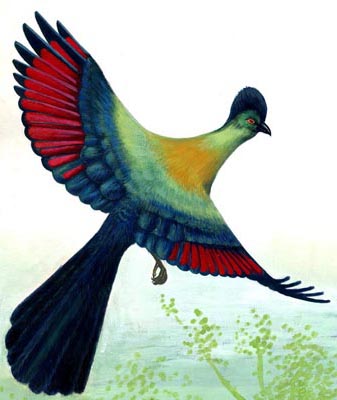The ENTC now has a new website, at www.entc.org.sz
Our logo is adapted from a painting by Phillip Dlamini, 1998, of a purple crested turaco. In traditional Swazi dress, the red feathers feature in the royal headdress, so this bird illustration is not only a symbol for wildlife conservation, but also of cultural heritage.


Contributed by Wisdom M D Dlamini, Swaziland TFCA Programme Manager, 2005
"The Lubombo Route" brochure available for downloading: Page 1 (outside), Page 2 (inside).
Joint Press Statement by Ministers Fernando Sumbana (Mozambique), Thandi Shongwe (Swaziland), and Marthinus Van Schalkwyk (South Africa) on 6 May 2006: Ministers Launch New Lubombo Tourism Route At Indaba 2006
The Kingdom of Swaziland, through the Swaziland National Trust Commission (SNTC) is involved in various Transfrontier Conservation Areas (TFCAs) together with the governments of South Africa and Mozambique. The SNTC sought and received funding from Peace Parks Foundation for the implementation and operationalisation of the TFCA programme.
The Kingdom of Swaziland lies at the centre of an area critical to biodiversity conservation in Southern Africa. Linking the individual attractions of a particular country with those of its neighbours offers considerable advantage in more effectively and synergistically marketing these ecotourism destinations across national borders, for the greater benefit of participating countries. These benefits will support broader political aims of socio-economic upliftment throughout the subcontinent where rural areas are chronically subject to high unemployment and low income, as well as greatly improved regional ecosystem management. The Transfrontier Conservation Areas (TFCA) concept therefore aims at improving the quality of life of the people of the participating countries by means of the interstate collaboration and promoting sustainable use of natural resources, whilst at the same time managing for the conservation of trans-boundary ecosystems and associated biodiversity.
Together with the Biodiversity Conservation and Participatory Development (BCPD) Project, this project aims to encourage and support integrated and sustainable biodiversity conservation and socio-economic development in Swaziland through cross border collaboration with the Republics of Mozambique and South Africa. Swaziland's rich biodiversity resources are seen as the catalyst for this development and tourism the anchor economic activity. The program will also help achieve implementation of the country's environment and development policies. The Swaziland National Trust Commission (SNTC), the Swaziland Environment Authority (SEA) and the Ministry of Economic Planning and Development continue to play leading roles in this regard.
The study area for the project is the kingdom of Swaziland with a focus on the Lubombo and Malolotja-Songimvelo TFCAs. Hence effort and resources will be given to the transfrontier interactions with tourism and conservation efforts on the identified areas.
This proposed TFCA straddles the border between South Africa, Mozambique and Swaziland. This TFCA was initiated as part of the Lubombo Spatial Development Initiative It encompasses an area between the Lubombo Hills in the west, and the Indian Ocean in the east, and offers a unique combination of big game, extensive wetlands and coastal areas. The TFCA, as initially conceived, is 4,195 km2 in extent, of which 317 km2 (8%) is in Swaziland, 2783 km2 (66%) in Mozambique and 1095 km2 (26%) in South Africa. Local communities within and around these areas form part of the project area. Sub-TFCAs in which Swaziland is involved are as follows:
Community involvement and private sector participation is critical in the design and implementation of TFCA initiatives. The active involvement of the different tourism authorities from the three countries in the initiative could successfully complement its implementation. The cross border collaboration presents an opportunity for the country to tap into tourism flows to and from South Africa and Mozambique, e.g. the upcoming 2010 world Cup. The Bulembu Asbestos Mine tourism developments present an opportunity to be part of the initiatives of this TFCA. The Maguga Dam and surrounding areas present another opportunity to further activate the TFCA.

The General Transfrontier Conservation and Resource Area Protocol was signed between the Governments of the Republic of South Africa, Republic of Mozambique, and Kingdom of Swaziland on 22 June 2000 the Lubombo TFCRA. Download protocol (pdf 742 Kb). The objectives of the TFCA Programme are, to facilitate:
Our Contacts:
Head Quarters: (+268) 2416 1489/1179
Email: info@sntc.org.sz
King Sobhuza II Park: (+268) 2416 1489/1179
Email: ksmp@sntc.org.sz
National Museum: (+268) 2416 1489/1179
Email: curator@sntc.org.sz
Copyright © ESWATINI NATIONAL TRUST COMMISSION
Malolotja Nature Reserve: (+268) 2444 3241 / (+268) 2416 1480
Email: culturalvillage@sntc.org.sz
Mantenga Nature Reserve and Swati Cultural Village: 2416 1151/1178
Email: culturalvillage@sntc.org.sz
Mlawula Nature Reserve: (+268) 2383 8885 (Reception)
(+268) 2383 8453 (Senior Warden)
Email: culturalvillage@sntc.org.sz
Magadzavane Lodge: (+268) 2343 5108/9
Email: magadzavane@sntc.org.sz